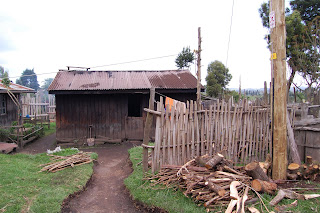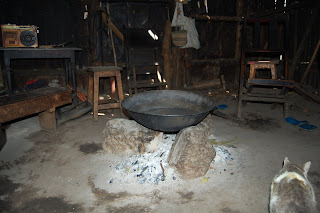
At the tail-end of our foray through western Kenya, we were invited to have lunch at E’s friend Mary’s family’s house. Mary is Kikuyu, the most populous tribe in Kenya, which is originally from the central highlands, north of Nairobi. Mary is a teacher at E’s school and was heading home for the holidays. When she found out that we would be in her area, she was very excited for us to visit. In fact, she asked us to visit and stay for a week and she was completely serious.
Normally we would have politely refused so as not to place undue burden on our hosts but Mary was so excited to have us that we decided that we should go. We had to ask her 4 times what we could bring as a gift to her parents before she reluctantly said we could bring some sugar (a common gift in rural Kenya). In Kenyan culture, the guest is the person who receives gifts or honors. E had to insist that in our culture it would be rude to arrive without a gift so Mary would accept the sugar. Luckily Mary is a good friend so this negotiation was all done in good humor.
In order to get there we were instructed to pull off of the main freeway at a specific market, where Mary would meet us and help to guide us on the rest of the drive to her house, as there are often no street signs in big cities, let alone the Kenyan countryside. This particular market was one of the largest produce markets in Kenya, and our stopping elicited full-on sprints from a dozen veggie hawkers. We were later informed that our merely having a car was incitement enough, but because we were wazungu as well, it was a perfect storm for the hawkers. A man with a five-gallon bucket full of carrots comes to the drivers’ side window and literally starts dumping carrots into the car. “Only 300 for all!”. “Sitaki kununua leo” (we don’t want to buy today). This did nothing to distract the mob. People were leaning and sitting on the car, just waiting us out; it was similar to a reverse safari. We joked that they were saying “ooooh, look at the wazungu reading, look at their funny clothes, etc.”. Finally, Mary arrived and as we pulled away out of the throng, hawkers slowly peeling off of the vehicle, a women confusedly shouted “you don’t want cabbage?!”.
The drive to her family’s house took about 15 minutes on a pretty rough dirt road, past verdant hills and fields, and children shouting “mathungu!” (in Kikuyu, ‘z’ or ‘s’ is pronounced as ‘th’), we arrived at the house (shown above).
Mary's church from their yard:

Mary’s parents greeted us as we arrived by warmly shaking our hands and guiding us to their sitting room. It was a small, concrete-floored room with a few couches and coffee tables, with old family pictures adorning the walls. An entertainment center was used for storage, and to house a very small TV, which was powered by a car battery (Mary later explained that they paid for the installation of electricity in October and are still waiting for it to be hooked up) . We sat and spoke for a few minutes, though Mary had to do a lot of translating, as her mother only speaks Kikuyu, but her father spoke some English and Swahili, so we could communicate directly.
The sitting room:

We spent about 5 minutes talking and 4 of these minutes were spent asking us when we could come back to stay over. Now we see where Mary gets her generosity from! Soon after our arrival, Mary’s father left to attend a dowry negotiation for a family friend, and Mary’s mother went to the kitchen to prepare lunch. We took the opportunity to tour the family’s property. Mary’s family owns five acres, and like many rural Kikuyu, they are farmers. The central highlands are known as the “breadbasket of Kenya”; the temperature is moderate, the rains consistent, and it’s right on the equator, so conditions for growing are ideal. We first passed the three milk cows, which produced the milk that we would have in our chai later in the afternoon. We then came to the kale fields. Because of the long (read: eternal) growing season, kale basically becomes a tree. The plants were taller than me. E and I have dabbled in gardening, and found out that while greens grow like a champ in the spring, once the summer heat hits, they bolt (i.e. flower), and the greens production is done for the year. Well, it never gets that hot in the highlands, so they just grow and grow. The soil is really rich and dark and the whole countryside is so green; the growing season is literally year-round in this part of Kenya. Mary said their trees are never without leaves and the leaves never change color. E’s tried to explain “daylight savings time” to Mary before but there’s a lot lost in translation giving the constant growing season and the fact that on the equator the sun rises and sets at the same time all year round.


Mary’s family also grows potatoes, peas, carrots, cabbage, plums, and pears in copious amounts most of which they sell at the market or to brokers. Further down the hill, freshly-shorn sheep and cows grazed in their pasture. Quite the bucolic scene. We then find out that Mary’s parents and one assistant manage the entire 5 acre farm themselves! Without any machinery or beasts of burden!
We then sat for a lunch of mashed potatoes and peas, and a carrot, pea, and beef dish. Both were delicious and very filling. After lunch, while Mary’s mom milked the cows, we sneaked into the kitchen for a look. While the sitting room looked like it was from the past twenty or so years, the kitchen could have been from the 1700s. It was a dark and very smoky dirt-floored room, with a central fire surrounded by three stones, on which rests a large wok-like pot. While in the cities people have fairly modern kitchens, this is status quo in rural Kenya. See below.

At around 3:30, we said our (extended) goodbyes so we could get back to Nairobi to return our rental car; this included her mom giving us a Kikuyu blessing before we left, very cool.
E, Mary, and Mama Mary:

As we were about to pull away, Mary said to us “my mom is upset that you’re not carrying home potatoes and carrots”. We were already a little overpacked from our trip, so we agreed that Mary would bring us some when she returned to the coast after the holidays, and this seemed to satisfy her mother. There were several times when we had these exchanges with Mary:
Mary: Do you want tea?
Us: Oh, no, it’s ok, we’re fine
Mary: Well, we always take tea after lunch so mom will make it and then throw it out rather than not make it
Us: Oh, then we’ll take tea
As Americans, our focus is to avoid work for our hosts and minimize our impact. As Kenyans, they seek to serve the guests and are constantly worried you’re offended if you refuse to take what is offered. Luckily Mary and E have figured out how to explain these things to each other so it all worked out but the differences are very interesting; they start every 5th or so sentence with “in our culture” and Mary’s been a fantastic guide.
We had several hours to kill in Nairobi and since it’s not known for being the safest city, we decided that we would wait it out in the upscale mall on the outskirts of town. This mall could have been in America, it was very surreal after the last 4.5 months and especially after the last 4.5 hours. Neither of us really like malls but this mall had sushi and we’ve been craving that so we grabbed some spicy tuna maki before our bus. Pretty confident that we’re the only two people in the world who had Kikuyu food for lunch and Japanese food for dinner yesterday.
The overnight bus in this direction was significantly less comfortable but we made it unscathed. Trip stats:
Distances covered:
By bus: ~700 km
By car: ~1000 km
On foot: 22 km + some hiking
Animals:
Rhino: 1
Flamingos: Thousands
Baboons: 50
Creepy storks: 20
Purchases:
Carrots: ~25, for ~$0.35
Mangos: 12, for ~$0.75
Yogurts: 2, for $2.00
Misc:
Potholes: conservatively, 20 million
Bad facial hair: 3 days worth
Wazungu-related heckling: Constant
Oh, my poor little heckled wazungu! I'm sure they were saying only nice heckles.
ReplyDeleteBut anyway, it sounds you're fitting in as far as possible given your appearances. It's nice that you could visit Mary's family. Is it cooler there? When I look at the photos, I can't imagine it being tropical heat, but who can tell from a photo, right?
Happy St. Nicholas Day! We will celebrate with chicken pot pie and some St. Nicholas Day cookies (chocolate chocolate chip - they are St. Nicholas cookies only because I am making them on the day.)
Aunt Patsy told me she reads your blog every evening - Laurie C reads it every morning. Lots more people read it than post, evidently!
Keep up the interesting posts. We are all becoming so educated about Kenya. BTW, I noticed that the OCA has a mission in northern Kenya somewhere - I can find out more if you're interested.
Love you!
McMom
Great posting, Max, and I'm laughing out loud at your metrics! Very amusing and the trip to Mary's family home, very, very moving. Like your trip, this posting was a study in contrasts. It's humbling and so intriguing to live in another culture, and you two are adapting and learning and sharing -- thank you for giving at least some travelling Americans a good reputation.
ReplyDeleteAmazing the generosity, the diligence to freely succeed through hard work, and the openness to you both. You have made yourselves accessible, and the Kenyans know good hearts when they see them. So proud of you two!
Much love,
L/Mom